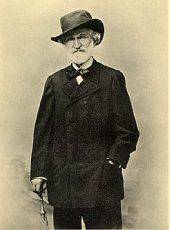

Giuseppe Verdi
8 Romanze
Short instrumentation: 2 2 2 2 - 2 2 2 1 - timp, perc, hp, str
Duration: 25'
Text bearbeitet von: Luigi Balestra
Text von: Jacopo Vitorelli, Temistocle Solera, Felice Romani, Andrea Maffei
Dichter der Textvorlage: Johann Wolfgang von Goethe
Bearbeitet von: Luciano Berio
Dedication: a Mimma Guastoni con affetto
Solos:
tenor
Instrumentation details:
1st flute
2nd flute
1st oboe
2nd oboe
1st clarinet in Bb
2nd clarinet in Bb
1st bassoon
2nd bassoon
1st horn in F
2nd horn in F
1st trumpet in C
2nd trumpet in C
1st trombone
2nd trombone
bass tuba
timpani
percussion
harp
violin I
violin II
viola
violoncello
contrabass
Verdi - 8 Romanze transcribed for tenor and orchestra
Printed/Digital
Translation, reprints and more

Giuseppe Verdi
Verdi: 8 Romances for tenor & orchestraOrchestration: for tenor & orchestra
Type: Studienpartitur
Language: Italienisch


Sample pages
Audio preview
Work introduction
Luciano Berio on his arrangement of Verdi's Eight Romances
It is my belief that these eight romances for voice and piano (whose dates of composition are mostly unknown to me) can be considered as true studies, in embryonic form, for scene, arias, and cabalettas of Verdi operas. In fact they contain echoes of “Nabucco”, “La forza del destino”, “Don Carlo”, and even an entire phrase, “Tacea la notte placida” from “Il trovatore”.
It would have been possible for me to orchestrate these expressive and idiomatic romances alla Verdi, in other words, to resuscitate the orchestral mannerisms of early Verdi traceable in the piano part, which itself behaves like a transcription from the orchestra, a “piano-vocal score”. (The code of intrinsic and pragmatic functionality linking orchestral score and reduction in Italian opera is a subject which would perhaps merit close study because of its implications for musical poetics and dissemination.) Instead I have not approached the orchestration in a homogeneous way, because these eight pieces, for all their Verdian style, are quite different from each other in expressive character, musical density and the quality (often abysmal) of their texts.
At times I have paid homage to Verdi by authentically reconstructing his orchestral gestures, at other times I have commented historically on the original musical discourse in such a way that it seems to have come from a distance (from the Verdi of “La Traviata”, for instance, or the Wagner of “Lohengrin” or from somewhere else). Finally, I have sometimes commented on the original text with discreet thematic proliferation or with harmonic transformations which, though organically bound to the Verdian text, tend to produce an “out-of-joint” effect which, I suggest, would have intrigued Verdi as much as Brecht.
I could cite a few instances where this effect of alienation (whose meaning can be perceived only by musical ears) has become unavoidable. In the romance “Deh pietoso, oh addolorata”, on a text by Goethe (but made unrecognisable by the disconcerting translation of Signor Luigi Balestri), Verdi quotes – though I suppose one should speak of anticipation rather than quotation – “Samson et Dalila” by Camille Saint-Saëns. I could not resist the temptation to adapt a certain passage in the Verdi romance to the harmony and refined instrumental colour of the French composer. This and other adaptations help therefore to set the eight romances in a respectful and subtle web of musical references which comments, with the hindsight and distance of 150 years, on the relationship of Verdi’s language, style and manner with time as it passes.
